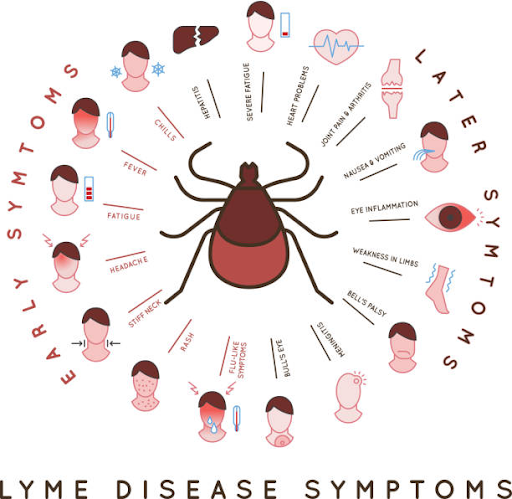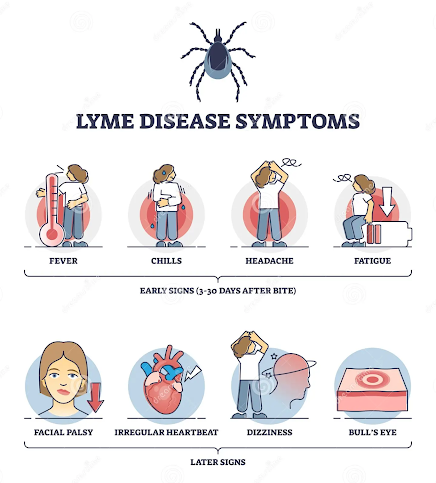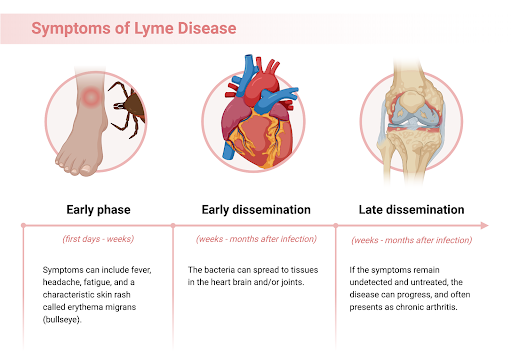
Lyme disease is caused by the bite of black legged ticks commonly called deer ticks. When the tick bites a bacteria named Borrelia burgdorferi, gets transmitted into blood through it and causes infection. This bacteria multiplies and penetrates into various organs of our body system and results in serious illness. But the complications of serious illness can be prevented if diagnosed at the early stage.
Lyme disease symptoms are broad, with more than hundred different are recorded till now and these symptoms can change with time, as the Borrelia burgdorferi spreads through the body. One of the hallmark initial symptoms is EM (erythema migrans), which occurs in 70 to 80 percent of infected individuals and emerges at the site of infection. Other symptoms – Fever, Headache, Fatigue, Muscle Joints, and Swollen Lymph Nodes.
How Lyme Disease Begins: Early Signs to Watch For

The early signs of lyme disease can go unnoticed because it has symptoms similar to that of other diseases like flu. But it is important to consider the early signs carefully otherwise it may leave you in a serious condition or complications in treatment. Key symptoms are–
Tick bite bull’s eye rash: It is also known as Erythema Migrans(EM). It takes 3 to 30 days to develop in the body post a tick bite.
- It looks like bull’s eye in circular or enlarged oval shape
- It looks like reddish ring like in the top skin and bluish hue in the bottom skin
Flu-like Symptoms: If a person is infected with lyme, they may experience muscle pain, chills, fevers, and even fatigue. These symptoms are similar to flu virus so, it is crucial to identify whether these feelings develop after a tick bite or not.
Joint pain: In the initial stages it is possible to have mild joints especially in the large joints like the knee or other areas and cause discomfort.
The Importance of Recognizing Early Lyme Symptoms
Why is early detection considered crucial for Lyme illness?
When Lyme condition is undiagnosed and left untreated it may result in complications that affect the heart, nervous system and joints. As the days progresses it may also other lyme disease symptoms like
- Swollen Lymph Nodes: A swelling around the neck, or armpits may be noted.
- Headaches: Persistent or severe headaches together with sensitivity to light.
- Unexplained Fatigue: Mild tiredness with no apparent reason occurs frequently even after adequate rest during the early stages of the illness.
What Does a Tick Bite Rash Look Like?

The primary indicator of tick bite is the bull’s eye rash. Note that all individuals may get these signs and make it difficult to understand to find out at the early stage. In such cases it is crucial to understand the variations in its symptoms.
- In most cases, the rash is not itchy or painful but feels warm to the touch.
- This rash may fade on its own with some just dismissing it as a nuisance.
If you find this rash developing, especially after a tick bite, consult your physician right away.
How to Differentiate Lyme Disease Symptoms From Other Illnesses?

Fever:
Although fever is common, in Lyme disease, it occurs together with a rash or some other specific symptoms.
Fatigue:
Lyme-induced fatigue feels more intense and enduring.
Localized Pain:
Joint or muscle pain tends to be asymmetrical and localized in Lyme disease.
Quick steps to Take After a Tick Bite

- Remove the Tick Safely: With the help of fine-tipped tweezers, grasp the tick as close to your skin as possible and pull it steadily upwards.
- Clean the Bite Area: Use soap and running water to wash it off or rub some alcohol on the affected area.
- Monitor for Symptoms: Ensure for a tick bite rash, flu-like symptoms, or other Lyme disease signs.
- Consult a Doctor: If symptoms appear, seek medical advice promptly for early Lyme detection.
The Key Takeaway
Staying informed about Early Signs of Lyme Disease, common Lyme disease signs like the tick bite rash and flu-like symptoms, can help act immediately and get effective treatment.
It helps to protect yourself and your loved one from getting affected seriously. Remember, prevention is always better than suffering, spend your outdoors mindfully, observe the early signs carefully if suspected. Early action can make all the difference.
Even though it does not require any medical emergency unless it is if you find any symptom develops as follows:
- A rash that looks peculiar or unusual skin changing areas that show a tick bite.
- Flu-like feeling that doesn’t get better.
- Pain or swelling in affected joints that are intense.
It is always best to seek doctor advice. Antibiotics prescribed at an early stage means one doesn’t have to suffer the chronic stage of Lyme disease.
The chances of complete recovery for patients with lyme disease depends on how early it is diagnosed and treated effectively. Supportive measures that can help with these conditions include rest, hydration, physical therapies, and most importantly emotional support from the family.
Reference
- Alliance GL. Symptoms of Lyme Disease – Global Lyme Alliance. www.global lyme alliance.org.2021 Sep 29
- How to Remove a Tick – Bay Area Lyme Foundation [Internet]. Bay Area Lyme Foundation. 2024 [cited 2025 Feb 8]. Available from:
- Global Lyme Alliance. How To Properly Remove a Tick | How to Remove Tick on Skin. Global Lyme Alliance.org. 2023 [cited 2025 Apr 2]. [GLA]
- CDC. Chronic Symptoms and Lyme Disease . Lyme Disease. 2024.[CDC]







